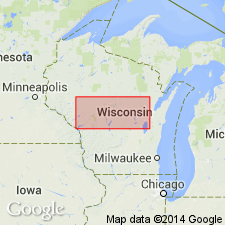
- Usage in publication:
-
- Wolf River Quartz Monzonite
- Modifications:
-
- First used
- Geochronologic dating
- Dominant lithology:
-
- Quartz monzonite
- AAPG geologic province:
-
- Lake Superior region
Summary:
First used as lithodemic unit of the Wolf River batholith in central and northeastern WI in the Lake Superior region. Type not designated; derivation of name not stated. Generalized geologic map shows contacts with Red River Quartz Monzonite (new), Belongia Granite, undifferentiated Paleozoic rocks, and Precambrian rocks older than 1,450-1,500 m.y. U-Pb concordia intercept age of about 1,500 m.y. is considered most reliable age estimate of the batholith. Resembles Waupaca Quartz Monzonite (redescribed) in being very coarse grained and porphyritic with prominent ovoidal alkali feldspars (1 to 3 cm long), but rapakivi texture much less abundant. Alkali feldspar and plagioclase phenocrysts in medium-grained matrix of interstitial, subhedral to anhedral quartz, microcline, plagioclase, biotite, and amphibole. Bulk of this unit is quartz monzonite, but grades into granite to northeast in contact with Belongia Granite. Bulk chemical analysis given. Age is Middle Proterozoic.
Source: GNU records (USGS DDS-6; Reston GNULEX).

- Usage in publication:
-
- Wolf River Granite*
- Modifications:
-
- Redescribed
- Overview
- Dominant lithology:
-
- Granite
- AAPG geologic province:
-
- Lake Superior region
Summary:
Consists of red, coarse-grained rapakivi granite; contains large (1-3 cm) ovoid to subhedral alkali feldspar sporadically mantled by plagioclase and interstitial plagioclase (An15-20), quartz, biotite, and hornblende; the Fe-Ti oxides are primarily ilmenite and lesser amounts of magnetite. Is the oldest and largest pluton of the Wolf River batholith, accounting for about 50 percent of the mapped area. Contains large inclusions of anorthosite and is intruded by dikes of Red River Granite (Middle Proterozoic). First described as the Wolf River Quartz Monzonite (Van Schmus and others, 1975); the unit was called "Wolf River granite" by Anderson (1980). Is formally redescribed here as the Wolf River Granite, following the classification of Streckeisen (1976). Is named for exposures along the Wolf River; exposures along the river between the villages of Markton, Oconto Co, and Keshena, Menominee Co are designated as the type area. Is mapped in Marathon, Shawano, Menominee, and Oconto Cos, WI in Lake Superior region. Age is Middle Proterozoic.
Source: GNU records (USGS DDS-6; Reston GNULEX).
For more information, please contact Nancy Stamm, Geologic Names Committee Secretary.
Asterisk (*) indicates published by U.S. Geological Survey authors.
"No current usage" (†) implies that a name has been abandoned or has fallen into disuse. Former usage and, if known, replacement name given in parentheses ( ).
Slash (/) indicates name conflicts with nomenclatural guidelines (CSN, 1933; ACSN, 1961, 1970; NACSN, 1983, 2005, 2021). May be explained within brackets ([ ]).

